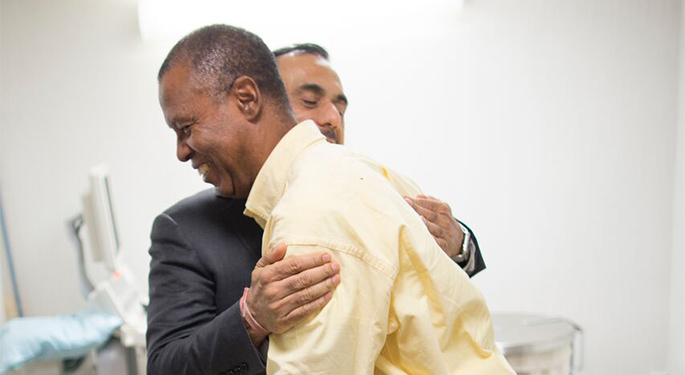After Your Prostate Robotics Surgery

Right after the procedure, we will transfer you to your room. You will have six small bandages over the skin incisions, a drain on one side of your abdomen attached to a vacuum container, and a urine catheter (Foley) to drain urine from your bladder attached to a urine bag. An intravenous (IV) line will provide fluids. We will probably stop using the IV and drain the day after surgery. You will be allowed to have ice chips and sips of water. You shouldn’t have much pain, but we can give you pain medication if necessary.
Once you are ready, you should sit up and walk a few steps. Early walking is the key for fast recovery and return to bowel activity. It also improves blood circulation in the legs and prevents clot formation.
The next morning, we will give you a light breakfast and a liquid diet. You cannot have solid food until you pass intestinal gas and have a bowel movement. Most people do not pass intestinal gas for several days and do not have a bowel movement for three to four days
The best way to a speedy recovery is to start walking the hallways on the day after surgery. We expect you to walk a total of one mile, or 25 laps around the hospital wing (not necessarily all at once).
We will give you a breathing device called a spirometer to use once an hour. This will help expand your lungs and prevent infections. Every hour, you should take 10 consecutive deep breaths with it in your mouth.
Most of our robotic prostatectomy patients return home the day after surgery.
Urine Catheter/Urinary Control
When you leave the hospital, you will still have the urinary catheter in place. The catheter will remain for approximately six to nine days after the operation. We will attach the catheter to a leg bag that you can hide under your pants. At nighttime, we recommend that you switch to a regular urinary bag that you place on the side of the bed. This is a larger bag that will allow you to sleep the whole night without having to get up to use the toilet.
You may experience some bladder pain or cramps (spasms) associated with the catheter, but most people tolerate it well. You may also leak minimal amounts of urine around the catheter because of involuntary bladder contractions. You may want to wear a pull-up diaper over the catheter to prevent soiling your clothing. It is also not unusual to notice pink or red tinged urine after a walk or bowel movement. Do not be alarmed. Simply increase your fluid intake until the urine becomes clear again and lie down for a while. All of these events are considered within normal range, and are not cause for concern.
On the day of your scheduled catheter removal, we may need to perform a cystogram at the hospital. To perform a cystogram, a radiologist injects dye through the catheter and takes an X-ray to make sure that there is no leakage at the point where the bladder and urethra connect. You will then go to your surgeon’s office for removal of the catheter (a relatively pain-free procedure). Right after the catheter is removed, most men cannot control the urine sphincter and leak urine for a few days to weeks; many people stop within a few hours or a few days. We encourage you to bring adult diapers and protective pads with you on the day we remove the catheter.
Activity
You can return home by car from the hospital after discharge if your drive is within two hours, but you should not drive for two weeks after the procedure. If you come from out of state and are traveling by plane, make sure that you walk every half hour in the plane cabin to prevent blood clotting in the legs.
It takes three to four weeks for the abdominal incisions to heal completely, so you should avoid heavy lifting during that time. You may have some swelling in the scrotum and penis after surgery, which will resolve with time. If you experience this swelling, elevate your scrotum using a folded towel when you lie down, and wear mildly tight underpants when you move about.
You can shower any time after surgery, but do not take a bath until after the urine catheter is removed. Leave the bandages on the skin incisions for three to four days. When you leave the shower, be careful to pat, not rub, the incision area dry.
You can start daily activities (such as walking and climbing stairs) immediately when you get home. However, you should wait three to four weeks before beginning any heavy exercise, such as jogging, weight lifting, and bicycle riding. Generally, you can return to work two to three weeks after the operation, depending on your job.